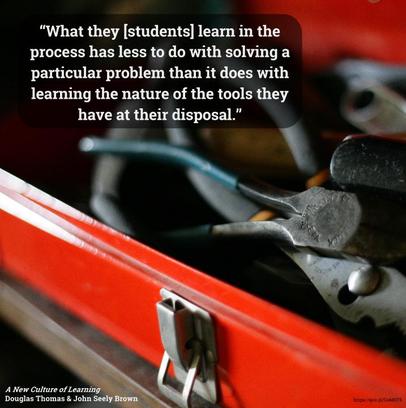 Chapter 4: Learning in the Collective Quote “Once a particular passion or interest is unleashed, constant interaction among group members, with their varying skills and talents, functions as a kind of peer amplifier, providing numerous outlets, resources, and aids to further an individual’s learning.” Thomas and Brown (2011) explain that the social interactions that take place in a collective continuously affect the learning of each individual. This synergy deepens learning in a way that cannot occur within private learning experiences. Question “In a collective, there is no sense of core or center. People are free to move and out of the group at various times for various reasons, and their participation may vary based on topic, interest, experience, or need. Therefore, collectives scale in an almost unlimited way.” How can teachers build collectives in traditional classrooms? How are common “topic, interest, experience, or need” identified and developed within a group placed together based on the criteria of age and geographic location? Connection “Simply by being among the people around them--in study groups, for instance--students are learning from their environment, participating in an experience rich in resources of deep encounters. ” In my previous online MA program through Ashford University, I did not have a collective experience--in fact, I was barely even part of a community. I wrote discussions, commented to peers, and submitted individual assignments. I was bored. I spent hours sitting alone reading, writing, and creating digital media projects. None of my peers (or, even professors!), authentically challenged me by responding to my work. It was like I was learning in a bubble that was occasionally nudged by a forced comment or rubric grade. As I began my online MA program, I knew that I needed to push myself to connect with my peers. Thanks to the environment provided through Google + and individual friendships I am forming, I am connecting. Many moments of deep thought and learning are actually occurring when I am not directly working on an assignment. The conversations my professors often do not hear (emails, instant messages, voice messages, texts, and phone calls) are sincerely deepening my learning experience and pushing me to develop my academic, collaboration, and leadership skills. I am already benefiting from the collective we are just beginning to build! Epiphany “In communities, people learn in order to belong. in a collective, people belong in order to learn. Communities derive their strength from creating a sense of belonging, while collectives derive theirs from participation. ” The term “community” is almost overused on my campus. San Pasqual Academy’s geographically isolated residential campus is a community with a unique culture. Most students are able to figure out how to behave to become a member of the community, but I am beginning to think that this is not enough. After learning about the differences between collectives and communities, I am questioning our focus on community. Instead, maybe we should strive to create a collective focused on helping foster youth learn how to heal and prepare for emancipation. Maybe? My brain is still processing this. Chapter 5: The Personal with the Collective Quote “The personal is the basis for an individual’s notions of who she is (identity) and what she can do (agency). It is not necessarily private, though it may be, and it does not exist in a vacuum. We shape and define the boundaries of our agency and identity within the collective.” Thomas and Brown explain, that contrary to the shared beliefs of western culture, individuals’ identify and agency are not simply developed through private or public conversations. Instead, they are developed through private and public interactions. Participating in collectives intensifies this growth. Additionally, technology creates avenues for collaborative communication, such as blogs, which extend the collective even beyond face-to-face interpersonal interactions. Question “Because learning with digital media occupies a space that is both personal and collective, people can share experience as well as knowledge. Here, people are not just learning from one another, they are learning with one another.” How does a teacher harness digital media to encourage a collective? Can individuals simply form a collective around the shared problem of passing a course? That does not seem like enough. What strategies have educators tried? Connection “Ryverson’s objections to the Facebook study group, which was nothing more than a digital re-creation of the physical-world study groups that have been around for centuries, were that it made learning easy, allowed students to do whatever they wanted, and as a result threatened academic integrity.” This week, a multiple-choice and short-answer midterm was assigned to our cohort. The instructions explicitly stated, “We expect individual graduate students to complete this task on their own...This is not a GROUP PROJECT.” However, over the past six weeks, we have been pushed by all three of our professors to use technology to work together, utilizing tools such as discussion board comments, Google+ community, and student-run webcasts. Like the Ryverson University students in the Facebook study group, we have already entered into a collective. Knowing that collective learning exists, it is incredibly challenging and almost unreasonable to expect us to simply snap back into individually completing an explicit learning task. Epiphany “And because there is no targeted goal or learning objective, the site can be used and shaped in ways that meet the needs of the collective.” My district is currently doing the opposite of this! Our current instructional coaches and administrators are heavily pushing learning targets and success criteria. During the last English Language-Arts training I attended, they shared specific learning targets and success criteria for for every little lesson within the California State University Expository Reading and Writing Curriculum. I agree with Thomas and Brown and foresee that I am going to struggle when I am told post daily learning targets and success criteria daily. Chapter 6: We Know More than We Can Say
Quote “Explicit knowledge, as we have seen, lends itself well to the process of teaching--that is, transferring knowledge from one person to another. You teach and I learn. But tacit knowledge, which grows through personal experience and experimentation, is not transferrable--you can’t teach it to me, though I can still learn it.” Thomas and Brown explain how explicit knowledge was valuable in “the old culture of learning.” But, technology has made explicit knowledge so easily accessible that now the role of educators is to develop tacit knowledge. The challenge is that tacit knowledge has to be experienced instead of taught; so, now, educators are challenged to create learning experiences instead of just directly teaching explicit knowledge. Question “When that tacit dimension is taken into consideration, the value of a university education grows to include the learning that happens when students are immersed in an environment that values learning itself.” Why do all of the academic examples focus on colleges and universities? Are primary and secondary institutions really that far off? What about schools like High Tech High? Connection “What they learn in the process has less to do with solving a particular problem than it does with learning the nature of the tools they have at their disposal.” The word “tools” instantly reminded me of Wesch’s 2010 video, “From Knowledgeable to Knowledge-able”, in which he makes the case that students needs to “embrace real problems... and harness relevant tools.” I am noticing a recurring message about the importance of helping my students build toolkits. Epiphany “Different people, when presented with exactly the same information in exactly the same way, will learn different things.” I already see this happening in my classroom! My students’ reading reflections provide evidence of it. Even when we read a novel as a whole-group during class and discuss the text together, each student’s reflection shares a unique connection to the text. When they are given writing prompts that allow them to explore any possible thesis with the requirement that they back it up by providing and explaining textual evidence, they are also able to to show their own perspective. I feel like my classroom may support more inquiry than I previously thought. Works Cited Thomas, D., & Brown, J. (2011). A new culture of learning: Cultivating the imagination for a world of constant change. Lexington, Ky.: [CreateSpace?].
7 Comments
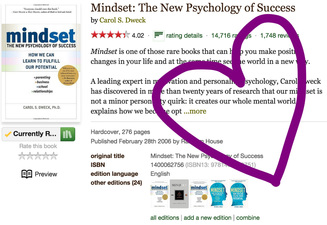 If you’ve taken a peek at my Goodreads account, you know that I have an extensive classroom library of high-interest young adult literature. As much as I love reading about teen love (Looking for Alaska), child abuse (Orphan Train), and dystopian societies (Maze Runner), I intentionally spend my nights reading these books because I understand the power of shared reading experiences and benefits of personal recommendations. So, when selecting my choice novel, I picked a book with positive reviews from five of my Goodreads friends and downloaded Catching Up or Leading the Way: American Education in the Age of Globalization. I started it. But, I also needed a new audiobook to listen to as I walk my dogs. I followed the recommendation of a friend and selected a book that also happened to be on Jeff Heil’s list. I must say, I have smart friends! I am totally in love with Mindset: The New Psychology of Success by Carol Dweck! I’ve already listened to a fourth of the audiobook. I meant for it to be a pleasure read, but I cannot stop pausing my walk to use the bookmark feature in Audible to record points I want to remember and jot down text-to-self, text-to-classroom, and tech-to-world connections. So, the audiobook wins! I am going to use Mindset for my choice book. I am looking forward to reading more, sharing my thoughts, and discussing the text with my smart friends. 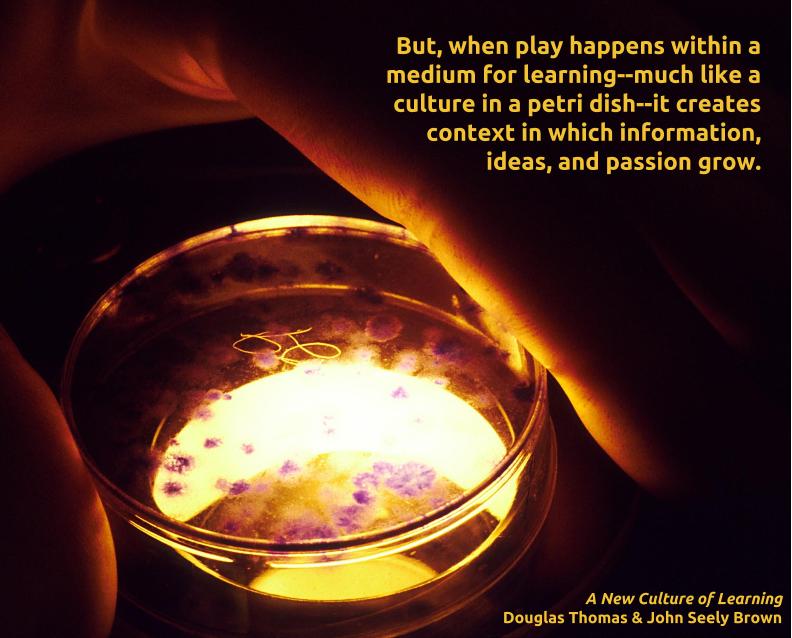 Chapter 1: Arc-of-Life Learning Quote “Play, questioning, and--perhaps most important--imagination lie at the very heart of arc-of-life learning.” Thomas and Brown (2011) provide examples of how people, of various ages and settings, willing choose to engage in learning that involves “play, questioning, and...imagination.” As I continue to read the book, I expect to learn how to bring these types of learning experiences into my classroom and school. Question “The new culture of learning gives us the freedom to make the general personal and then share our personal experience in a way that, in turn, adds to the general flow of knowledge.” What about the voices of students who are institutionally blocked from adding “ the general flow of knowledge”? Connection “The connection between resources and personal motivation led people to cultivate their imaginations and recreate the space in a new way.” 20time projects are a simple way teachers can motivate students to use their imaginations. In order to solve what Kevin Brookhouser calls “wicked problems,” students will need to utilize resources and their imaginations. Additionally, by selecting their own 20time project ideas, students will be motivated because they can explore a topic of personal interest. Epiphany “In the new culture we describe, learning thus becomes a lifelong interest that is renewed and redefined on a continual basis.” When I first began teaching, posters covered the walls of of many classrooms describing schoolwide goals of creating “lifelong learners.” However, the learning taking place inside of these classroom walls--lectures, movies, textbook questions, worksheets, and standardized assessments--was actually creating resistant learners and simply preparing them for the next phase of learning down the conveyor belt of public education. The idea of lifelong learning is nothing new. But, now technology provides increased access to learning. Chapter 2: A Tale of Two Cultures Quote “The primary difference between the teaching-based approach to education and the learning-based approach is that in the first case the culture is the environment, while in the second case, the culture emerges from the environment--and grows along with it.” Thomas and Brown use the two definitions of culture to frame their explanation of the way education is changing. They contrast the social science definition with the natural science definition. This figurative comparison helps me to link the growth of a culture in a petri dish to the learning of a student in a classroom. Question “Learning should be viewed in terms of an environment--combined with the rich resources provided by the digital information network--where the context in which learning happens, the boundaries that define it, and the students, teachers, and information within it all coexist and shape each other in a mutually reinforcing way.” What about teachers who have not yet utilized “the digital information network” as a learner? Connection “The second difference is that the teaching-based approach focuses on teaching us about the world, while the new culture of learning focuses on learning through engagement within the world.” This aligns with the skills that are taught through project-based learning units. This focus on skills rather than content also aligns with Common Core State Standards,National Council of Teachers of English’s 21st Century Literacies, and National Educational Technology Standards. By teaching students skills instead of just content, we are preparing them to actively participate in the world. Epiphany “If we change the vocabulary and consider schools as learning environments, however, it makes no sense to talk about them being broken because environments don’t break.” Honestly, over the past few months, I have engaged in many conversations about my school being “broken.” But, following Thomas and Browns’ perspective, I can see that my school may just be going through a bit of a drought. Chapter 3: Embracing Change
Quote “If the twentieth century was about creating a sense of stability to buttress against change and then trying to adapt to it, then the twenty-first century is about embracing change, not fighting it. Embracing change means looking forward to what will come next. It means viewing the future as a set of new possibilities, rather than something that forces us to adjust.” Thomas and Brown begin to prepare the reader for their arguments explaining how education by putting it in a broader context. It’s not just education that is changing--the whole world is changing. Question “Yet while people in other adult learning cultures, such as amateur hobbyists, are innovating like crazy, workplaces have become relatively moribund.” How can teachers be given opportunities to observe and understand innovative workplaces? Connection “What happens, then, when you are dealing with change on a weekly, daily, or even hourly basis?” This reminds me of the popular explanation of the old industrial model of education in which teachers and schools did not adjust to their students--much less changes to content and tools. At this time, it was possible to simply reuse the same classroom behavior expectations, routines, and curriculum year after year. The social culture and environment did not change. Currently, educators are challenged to respond to constant changes. Epiphany “And therein lies the major pitfall of the twenty-first century’s teaching model--namely, the belief that most of what we know will remain relatively unchanged for a long enough period of time to be worth the effort of transferring it.” Textbooks are filled with knowledge believed to be “worth the effort of transferring.” I have heard many discussions around textbooks becoming outdated, but this statement deepens the conversation by explaining knowledge is changing instead of just updating. Works Cited Thomas, D., & Brown, J. (2011). A new culture of learning: Cultivating the imagination for a world of constant change. Lexington, Ky.: [CreateSpace?].
I know that my first few Twitter chats were fast and intimidating, so when my classmates and I received an assignment to participate in two this month, I challenged myself to facilitate one for the first time to create a safe learning space. It worked! We all learned together!
Watch this screencast to learn how to add geotags back to photos after they have been edited.
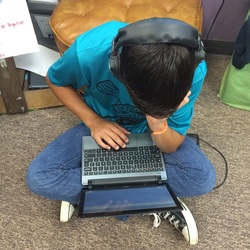 Silent Conversation using a Chromebook Silent Conversation using a Chromebook Even though technology is not mentioned in the blog post “A veteran teacher turned coach shadows 2 student for 2 days -- a sobering lesson learned” posted by Grant Wiggins, I have found that integrating technology into the classroom has the potential to actually deepen the “mistakes” noted by the anonymous classroom coach who spent two days shadowing a high school student. In the coach’s experience, “High school students are sitting passively and listening during approximately 90% of their classes” (Wiggins 2014). As a result of years of teaching with one-to-one laptops and Chromebooks at San Pasqual Academy, I have become very skilled at designing lessons to prevent my students from “sitting passively and listening.” My students are always doing something--such as revising a play, working on a group media project, or annotating an article. I am proud of my ability to harness online collaboration tools to support communication, but recently realized that simply helping my students actively engage and decreasing my talking time was not enough. Last year my school’s new instructional coach, Tracey Makings (@MakingsTracey), shared her insight after multiple observations of my classroom: my students were not talking. They were writing, reading, and creating, but they were not being given opportunities to practice and develop the skill of codeswitching into academic talk. And, our daily think-pair-share based on a news article only provided approximately two minutes of talk time for each student. Following my coach’s advice, I went into this year with a goal of helping my students engage in rigorous academic talk. In order to accomplish this classroom goal, I intentionally scheduled opportunities for face-to-face conversations, collaboration, and presentations. And, I had to put the Chromebooks away. I continued take advantage of my learning space; I pushed the students into groups for discussions sitting and standing around our tall triangular desks arranged into squares of four while allowing others to cluster up using chairs and stools from our classroom lounge. I broke my paperless rule and wrote conversation starters on poster papers and/or printed them. Just doing this was a challenge. I have been paperless for so long that it was my routine to create written instructions for every single little lesson, including instructions of how to submit evidence for credit. I felt the need to type questions, write discussion directions, and have at least one student record their group’s responses. I felt like I had to have proof of their learning. But, as they began talking, I noticed that they ignored my printed instructions and only used the prompts. I slowly began to let it go and trusted myself to just listen, observe, and naturally join into conversations as needed. I learned to place one of my additional adults in groups that needed a little direct guidance and allowed more independent groups to form and even stray from the planned topics. During my current unit, I was finally able to completely unplug and allow natural academic conversations to occur. My freshmen just finished reading and discussing the novel Orphan Train by Christina Baker Kline. Throughout the unit, I read aloud to them, they placed sticky notes on sections of the text relevant to our essential question, and we discussed their selections. This evolved into discussion days with specific learning targets, such as asking follow-up questions, with time for everyone to practice a new skill as we talked about the text. During our last few days of reading the book, the students began naturally interrupting me with small verbal responses such as gasps and excited blurts. I could hear the murmur and sense their subtle movements as I read words that evoked emotions and thinking. I would pause. We would quickly have a whole-group conversation about the text and then return to reading and searching for relevant text excerpts. All of this was unplugged-the Chromebooks were neatly stored in the cart for the entire period. I even just used a pencil checkmark on my roster to note which students participated. If I had allowed myself to instead revert to sending the students off to have conversations using a discussion board or even just having the them read online while adding highlights and comments, we would have lost the moments of discussions sparked by shared emotional responses. Unlike instructional coach in Wiggins’s blog post who wishes she “could go back and change [her] classes now,” I am currently changing my classes. As many teachers work to integrate technology into their lessons, I am working to find a balance between screen time and face time. Works Cited Wiggins, G. (Ed.). (2014, October 10). A veteran teacher turned coach shadows 2 students for 2 days - a sobering lesson learned. Retrieved June 20, 2015. 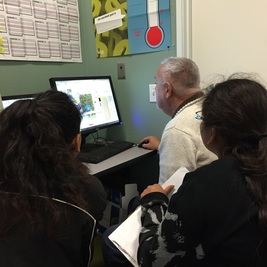 My Yearbook Students Receiving a Lesson from Our Representative My Yearbook Students Receiving a Lesson from Our Representative I would like to say that integration of technology and project based learning is helping to prepare my students to work at Google. But, in reality, my yearbook class is actually doing a better job than my English class. According to Thomas L. Freeman in “How to Get a Job at Google,” the five hiring attributes at Google are: cognitive ability, emergent leadership, humility, ownership, and expertise (2014). The students on my yearbook staff develop these skills as they work together to publish San Pasqual Academy’s yearbook. Cognitive Ability In order to create the yearbook, my students must explore and learn. Their cognitive abilities are tested throughout the design process. The class uses uses a program called StudioWorks to build our book. It is published by our supplier, Balfour, and is completely web-based. The interface is different from almost anything my students have worked with and a simple mistake of pushing a key command that works in another application may cause unsaved work to disappear. Since this program is Balfour’s product, very little just-in-time support exists. We are provided with guidebooks, a representative, and a technical support help desk phone number, but we cannot simply Google a YouTube tutorial when we are stuck. Additionally, yearbook staff is normally very small--only three to five students--and our master schedule often creates years when it is impossible to have any returning students in the class. Instead of walking them through each step of design and publishing, I push them to use their resources to figure things out, provide help when they are stuck, and encourage them to call the help desk phone number when we are all confused. As a result of these challenges, my students often spend hours teaching themselves. Emergent Leadership This spring break, my class faced an unplanned obstacle that escalated one of my students into an unofficial leadership position. My editor faced some personal challenges and had to step back from the project. To fill her place, the photo editor quickly took over. She taught herself to design pages and began delegating the photographic tasks to other students. When the editor returned, they combined skills and increased productivity. This simple challenge provided an opportunity for a student to display and practice emergent leadership skills. Humility In the revision process of creating the yearbook, I often come across a page that does not align with our design theme or contains a stylistic flaw, such as a photo of a person who appears on two consecutive pages. Situations like these create moments when honest, constructive criticism is necessary. In years past, I have had students completely shut down when I told them a page they had worked on needed to be redone or revised. However, when students are able to work through these setbacks, they are able to understand that humility is necessary to collaborate to accomplish a common goal. Ownership This year, ownership has been one of the biggest lessons my yearbook team has learned. In years past, I have swooped in and finished pages after deadlines were missed. The book was completed on time, but the students were not invested in the creation process or deeply proud of the end product. I realized that I had been taking away their ownership. This fall, I told my students that I would not finish the book for them. They did not believe me, because they know that I always swoop in and save them. Unfortunately, my girls are currently in the process of really learning the responsibility of taking ownership. We have already significantly missed our final deadline. But, I am letting them struggle. Instead of just dropping their grades and finishing it on my weekends, they are spending their weekends finishing the book. When the book is printed, it will be their book. Expertise Last year, my yearbook editor was a returning student to the class. Out of all of the students, he was our expert. However, he was not motivated to create the book and resisted teaching other students what he knew. As a result, he actually became more of a hindrance to the creation of the book--even though he knew more than anyone else! We saw that expertise is only useful when the expert is willing and able to contribute to a goal. Looking Ahead Even when I am just teaching an elective class, it is challenging for me to help my students develop the traits necessary to work somewhere like Google. I want to break things down into baby steps and micromanage their projects. I want to make sure they succeed, but I need to give them space to learn. As I look toward the upcoming school year, I want to push myself to create authentic learning experiences in my English classes. As I do so, I need to keep the following in mind:
Works Cited Friedman, T. (2014, February 22). How to Get a Job at Google. Retrieved June 21, 2015. Good Ideas Next, I began to consider real problems I do not know how to solve. I also began focusing on my school, because I know that I will be more likely to challenge myself if my students will benefit from my efforts. Instead of focusing on what the end-product will look like, considered the problem--if I knew what the solution would look like, it would not be a “wicked problem.” I came up with the following two ideas, which focus on using technology to help San Pasqual Academy’s (SPA) invested adults to increase our abilities to support our students. By the way, SPA’s strong team of invested adults include: San Diego County Office of Education Juvenile Court and Community school staff, New Alternatives residential staff, YES Program work readiness staff, San Diego County Health and Human Services Agency social workers, Voices for Children Court Appointed Student Advocates, San Pasqual Academy Neighbor grandparents, and miscellaneous educational rights holders. Idea A - Adult Communication Wicked Question How can technology help San Pasqual Academy’s invested adults communicate with one another? Current Problem We have more than 200 adults working together to support 85 students. We work for different agencies, work in different buildings, and work different shifts. Many of us do not even know each other’s names and are unable to identify which adults are connected to individual students. Inquiry Questions
Wicked Question How can San Pasqual Academy’s invested adults increase their familiarity with the social media platforms used by our students in order to support responsible practices? Current Problem We have had problems with conflicts connected to social media disrupting school and residential time. Our campus director recently told me that the majority of the student conflicts addressed by her and her staff involve social media. Many of the adults do not use or understand the platforms used by the students and struggle to teach and/or model responsible practices. Inquiry Questions
Brookhouser, K. (2015). The 20time project: How educators can launch Google's formula for future-ready innovation. San Bernardino, California: 20time.org. 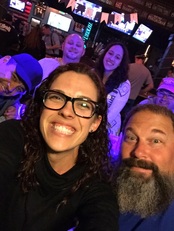 JCCS, New Alternatives staff, and SPA alumni at dinner after a SPA basketball game JCCS, New Alternatives staff, and SPA alumni at dinner after a SPA basketball game Initial Thoughts When I first began thinking about starting a 20time project, I was frustrated. I already enjoy making goals for myself and pushing myself to learn new things. Over the past few years, I have intentionally learned new hobbies and increased my practice of ones I had abandoned, including running, cooking, swimming, hiking, and most recently yoga. I am reading more, using Instagram to regularly share the work being done in my classroom, calling friends regularly, listening to podcasts and audiobooks, and even walking my dogs more. At first, I thought the 20time project was going to require me to integrate another passion into my jam-packed schedule. However after reading The 20time Project: How educators can launch Google’s formula for future-ready innovation by Kevin Brookhouser, M.Ed., I realized that 20time projects more than simply “passion projects.” Brookhouser (2015) explains, “The goal is not to give students school time and resources to play with a ‘passion project.’ It’s not even about the positive community impact their projects might have. It’s about developing the creative abilities needed to tackle wicked problems.” I decided to challenge myself to experience the 20time process while addressing an unsolved “wicked problem” on my campus. Bad Ideas First, I created a Bad Idea Factory brainstorm. Using this tool, it was easy to purge ideas from my list that were simply passion projects, easily solvable problems, unfocused ideas, and outcomes that would not help anyone else. Beginning Blogging When I was hired at San Pasqual Academy in 2006, the school was already blogging. I was expected to join my new colleagues by creating a blog using Blogger and to post homework assignments before leaving work each day. Sometime around 2009, I began having my students blog. I regret to say that I am unsure of the timeline because I actually deleted the first few years of my blog posts while I was pursuing my first MA because I was embarrassed of their outdated methods and content. Anyway, each student had a Blogger account and regularly posted their writing. I linked all of their blogs to my blog so we could share comments. The blogs were public. I shared URLs the students’ invested adults and taught them how to comment during conferences. Once we began receiving comments from strangers, we became excited. We added widgets that mapped the location of our visitors using little red dots. Eventually, we added labels--a predecessor to the hashtag--and used Google Reader to aggregate our feeds. The students used images, embed codes, and links to enhance their posts. As we began using Google Docs (now known as Google Drive) and Web 2.0 tools, they also embedded these into their feeds. I knew I was giving my students and authentic global audience, raising the stakes of their work, supporting collaboration, providing transparency, and increasing their technology skills while helping them build positive online reputations. This was more than five years ago. I was was one the early adopters. I believed in the work I was doing. But, I stopped. Changes Three years ago, my district, San Diego County Office of Education’s Juvenile Court and Community Schools, experienced changes in leadership. Under the previous administration, I had been encouraged to be innovative and was supported through obstacles. But, the technology coordinator was transferred to another department and the executive director and my principal were released. The new administrators, and administrators from the county office, began to express concern about potential problems that may arise from allowing students to produce public work using their own accounts using district devices and internet connection. I suddenly began to see potential mistakes as liabilities. Additionally around that time, my campus experienced a challenge in student privacy when the local newspaper asked to write an article about our football team but instead revealed information about a player’s father who had been involved in a major local news story. Our doors to global audiences began to close. Our “first-in-the-nation” residential academy that had aired graduation ceremonies on local television stations and been featured in numerous television shows and magazines, including the Today Show and Sports Illustrated, began to be more concerned with privacy than building our reputation. I was afraid the students’ lawyers and educational rights holders would not understand the benefits of their youths’ blogs. Instead of attempting to speak up, persuade them, or even create a compromise, I just moved away from the blogs. Also, I no longer needed my classroom blog to post assignments because I was using Edmodo, which created a Facebook-like assignment feed and gradebook. Currently, I use Haiku learning management system. My old classroom blog has not been updated since February of 2013. To address the safety risks, my district began using Google Apps for Education (GAFE) three years ago. Our technology resource teacher, Jeff Heil (@jheil65), encouraged and supported me as I guided my students in transitioning from their personal Google accounts to monitored GAFE accounts. My current juniors were the last class to create public blogs. Present Status Currently, my students have blogs, but we do not really use them. I do not even have a complete aggregated list of their links. We do not use the comment features. We still share our work publicly by posting it to their personal social media, but we do not intentionally write for a public audience. I know that I need to re-establish the practice of blogging in my English 9 and 10 classes. The student voices in “Transforming Teaching and Learning with an Authentic Audience” from Jeff Jakob (2013), remind me of why I need to find a way to reintegrate public blogging into my curriculum. As Grant Wiggins stated in the Jakob (2013) video, “Students work harder with a much greater focus on what they are trying to accomplish when there is a real and virtual audience they have to deal with.” I believe this. I have already experienced it. Now, I just need to have the courage to take risks by using blogging again. Blogs are a simple way to create opportunities for my students to connect with a global audience. Blog Archives I am forcing myself to share these blogs. I feel like I am sharing a draft version of a writing process and like I need to justify them. I will keep it simple. They are from years ago and I was still learning. They are not perfect. There are years of growth that has occurred since I left these behind, but that is for another time. Reference
Jakob, J. (2013, June 6). Transforming Teaching and Learning with an Authentic Audience. Retrieved June 15, 2015.
Last fall, I took a group of my sophomores to Fiesta Island for a bonfire as part of a storytelling unit. After the live storytelling concluded, we relaxed, chatted in small groups, and ate s’mores. After awhile, I noticed two of my girls had their cell phones out. My first reaction was frustration We were off campus having an authentic experience and they were on their phones! But, instead of snapping at them, I just observed. One was filming the other as she talked about her s’more. I inquired. They showed me a Snapchat story documenting the entire night. They were not avoiding the experience, they were actually documenting and sharing the highlights. They were still storytelling--just not the type I has pictured when I planned a night around a campfire.
Currently, I am a daily Snapchat user. I eagerly share my Snapchat excitement with other adults and have facilitated many tutorials filled with giggles and silly faces. Like most new social media tools, Snapchat is easier to just try than to try to explain. Snapchat feels natural because the messages are meant to be quick and temporary--just like face-to-face communication. However, the the back and forth sharing of photos and videos layered with drawings and text is a novel way to communicate. Snapchat is not just about sexting or selfies--it is a disruptive literacy. As Casey Neistat’s (2014) explains Snapchat is “about giving people an easy way to tell a story.” In his video “Snapchat Murders Facebook” he explains that Snapchat stories are different because they are disappear after twenty-four hours to create a sense of urgency and provide an authentic timeline (2014). However, he does not elaborate on how Snapchat creating a new form of communication that blends together images, text, drawing, and videos. As an English 9 and 10 teacher, it is my responsibility to help my students become literate young adults. Snapchat is another reminder that literacy now extends beyond simple reading and writing. I have not yet directly integrated Snapchat into a lesson (it was offered as an option on one project, but no one used it). However, I encourage my students to use it in class to record and share fun and interesting moments. I also model this by adding the moments to my own Snapchat story. Reference Neistat, C. (2014, October 2). Snapchat Murders Facebook. Retrieved June 14, 2015. |
@npriesterA collection of my learning from SDSU EDL 680 Seminar in Personalized Learning Archives
August 2015
Categories |
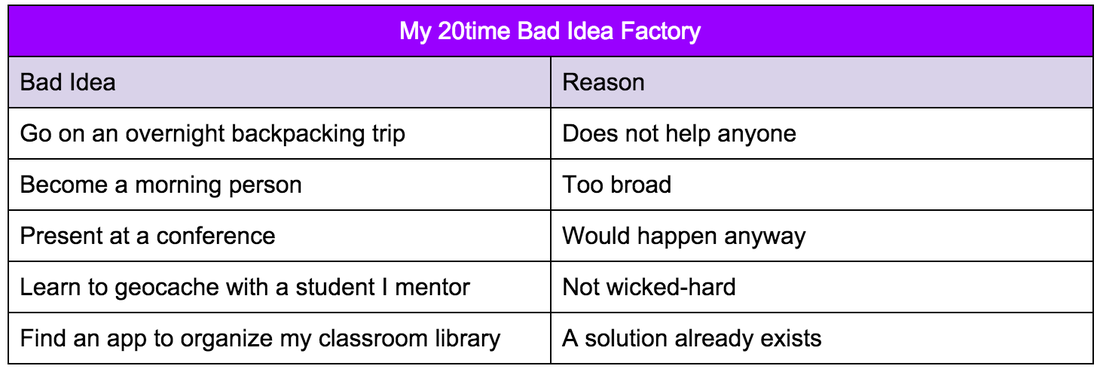
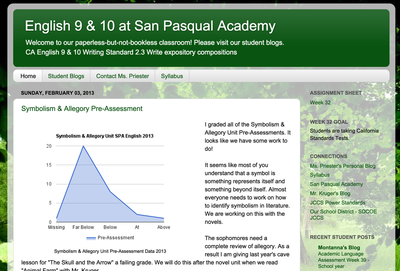
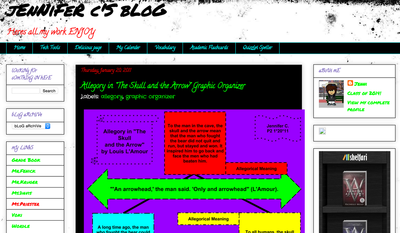
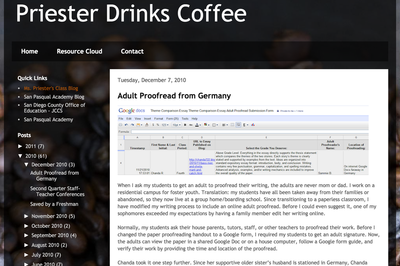
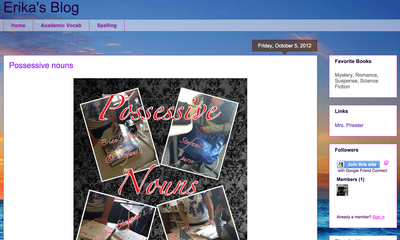
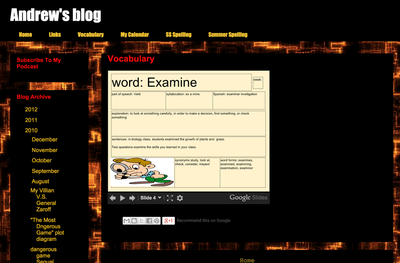
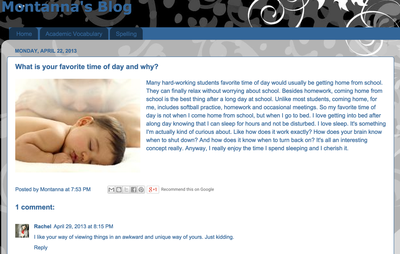
 RSS Feed
RSS Feed